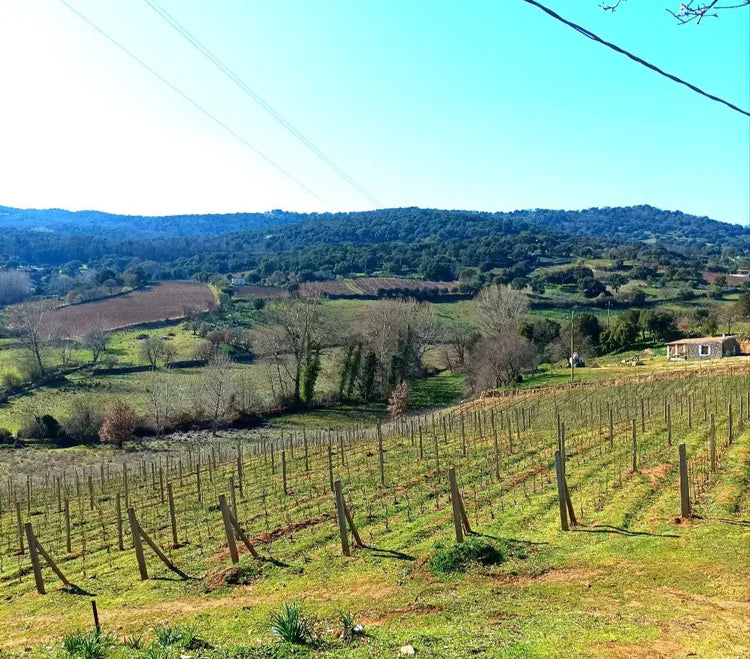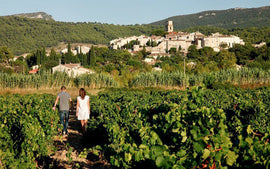“Sardinia”, said DH Lawrence, “is something else.” The famous English author was so smitten with the island that, following a brief trip there in January 1921, he composed the travelog “Sea and Sardinia”, which attempts to summit its essence via breathless hyperbole: “Sardinia is out of time and history.” Lawrence wrote. “This land resembles no other place. Enchanting spaces and distances to travel-nothing finished, nothing definitive. It is like freedom itself.”
More concretely, Sardinia is the 2nd largest island in the Mediterranean (after Sicily), situated 150 miles from the west coast of mainland Italy. It is one of four Italian regions enjoying semi-autonomous status; its specificity is the result of identifiable historical and material circumstances. Still, you can understand how Lawrence got carried away; from white sand beaches to alpine forests, across mountains, hills and plains, Sardinia covers 9,300 square miles of immense ecological and topographical diversity - an island that’s almost a continent, as it has been called before. Sardinia has also suffered numerous foreign invasions throughout its history - from Phoenicians, Greeks, Romans, Saracens, Spanish, French and Italians - and the landscape is dotted with evidence of the inhabitants' fierce resistance. There are some 7,000 ancient Nughari, or Bronze Age dressed stone circular defense towers built by the Nugari civilization (and for which no parallel exists anywhere else in the world) all over the island. More recently, you can find the slogan “Sardigna no est Italia”, which translates to “Sardinia is not Italy”, graffitied on many village and town walls.
One result of all this obstinance is a local culture and tradition that, while recalling Italy and Spain and other Mediterranean neighbors, is quite unique - from the cuisine (the great SF Sardinian restaurant La Ciccia does a beautiful job demonstrating this originality) to, of course, the wine. Besides being responsible for a whopping 80% of Italy’s cork production, Sardinia has more DOC and IGT titles than Calabria and Basilicata combined, inclusive of one DOCG wine, 19 DOC zones and 15 IGT zones, despite having the lowest wine production per acre of any Italian wine region. There are some 120 indigenous varietals grown in Sardinia, but the vast majority of planting and production is given over to just two: the red Cannonau (which is genetically identical to Grenache) and the white Vermentino (also grown in Tuscany, France, where it is called Rolle, and increasingly, California.)
Last time we were here we featured neither, so this trip we’ll be returning to the classics, a Vermentino and a Canonnau, each a face off between typicity and idiosyncrasy like any good Sardinian bottling. If these are the only examples you encounter this year, they are good ones, but they are also only the beginning of what this remarkable island has to offer.
Cheers,
Alan Hicks
Wine Buyer
Noe Valley
|
Deperu Holler ‘Fria’ Vermentino Isola Dei Nuraghi IGT 2023 |
|
|
Region: Isola Dei Huraghi, Sardinia |
About the Winery: In the north of Sardegna, Carlo Deperu and his wife Tatiana Holler are carrying forth Sardegna's winemaking traditions with passion, joy, and infectious zeal. The couple met in Milan, where Carlo earned his degree in viticulture and enology while Tatiana had come to study advertising from her native Brazil. In 2005, they settled back in Carlo’s hometown of Perfugas, where his family had long made some wine for home consumption. Carlo and Tatiana replanted the family vineyards and expanded their holdings, bringing the surface under vine to six hectares. This intersection of the hilly Anglona region and the more mountainous Gallura (home to Sardegna’s only DOCG, Vermentino di Gallura), features a fascinating mix of soils of sedimentary and igneous origin including limestone, clay, chalk, marl, shale, decomposed granite, and volcanic rock. Situated just ten kilometers away, the sea brings constant fresh breezes, while the cleansing maestrale wind plays a crucial role in facilitating organic viticulture. In fact, Carlo and Tatiana eschew herbicides and synthetic fertilizers in the vineyard, opting instead for regenerative solutions like herbal tisanes to treat the vines and planting cover crops to balance and protect their soils. Deperu Holler was among the first Sardinian wineries to bottle native-yeast-fermented whites, and they pay homage to the local field blends of the past through a deliberate use of skin contact to achieve deeper aromas and textures. Carlo avoids manipulations in the cellar as much as possible, working with gravity and in accordance with lunar cycles to bypass operations such as pumping, fining, and filtration About the Winemaking: Soil type: Limestone, clayey, granite disintegration, schists Training system: Guyot. Planting density: 5,600 plants per hectare. Yield per hectare: 60/70 quintals. Treatments: Copper, sulfur and biological preparations Vinification: Manual harvest. Two or three days of maceration on the skins, spontaneous fermentation, soft pressing. Aged in steel. The wine is bottled without clarification or filtration. Tasting Notes: Straw yellow tending towards golden in color. The nose is broad with notes of white pulp fruit, and resin. Fresh and savory and savory on the palate, with robust structure and a characteristic almond finish. |
|
Winemakers: Carlo Deperu & Tatiana Holler |
|
|
Price per bottle / Price per case $29.99 $323.90 |
|
|
Suggested Food Pairing: Tuna Tartare, Grilled Branzino Summer Minestrone Spaghetti Con Bottarga (see recipe) |
|
|
Catina Mertzeoro Barbigia Rosso IGT 2023 |
|
|
Region: Isola dei Nuraghi, Sardigna |
About the Winery: Mertzeoro is a family run company that was born in Mamoiada, in central Sardegna. For thirty years, they have been cultivating local vineyards and producing wine, though they only began bottling six years ago. A thousand bottles at the beginning, twelve thousand today. Always faithful to the substance: native vines, organic farming, no concessions to quantity at the expense of quality. As winemaker Catia Paddeu says “We tell the story of our land with hands dirty from the vineyard and our gaze turned towards tomorrow.” About the Winemaking: Mamoiada is a village of 2,500 inhabitants - and 200 family wineries(!) - located in the province of Nuoro and in the heart of Sardinia’s ruggedly beautiful and mountainous Barbagia area. The little agglomeration of houses that is Mamoiada is nestled in a land of often centuries-old vines planted at an average altitude of 736 meters above sea level. The vines are for the most part bush-trained, with a small minority of spur cordon- and Gujot-trained vines. Some of the old vineyards are still ploughed with oxen; the average age of the vines hovers around 40-50 years old, but there are many 100-year-old vines too. The total number of hectares under vine is around 350, of which 95% are planted to Cannonau and 5% to Granatza Cannonau wine producers of the Barbagia can only label their red wines either as Cannonau di Sardegna (which is a DOC) or as Barbagia Rosso (which is an IGT). Paradoxically, even though the latter is supposedly the lesser of the two wine categories (the DOC category is situated higher up in the pyramid of Italian quality wines than that of IGT wines) most of the Mamojada’s producers prefer to label their wines as Barbagia Rosso. This is because ‘Cannonau di Sardegna’ is an island-wide denomination, and therefore conveys little or no sense of place.. In Sardinia you can grow Cannonau high in the mountains and way down by the sea, and Barbagia is very much the latter. The Barbiga Rosso IGT is 100% Cannonau that undergoes spontaneous fermentation, a 15 day maceration and then 6 months aging in barrel and 2 months in the bottle. 4,000 bottles produced. Tasting Notes: Perfumed notes of raspberry nectar and cassis on the nose. Hints of licorice, violet, and cinnamon. Cassis, red berry and mineral flavors on the palate. Refreshingly light and lithe for a Cannonau. |
|
Winemaker: Catia Paddeu |
|
|
Price per bottle / Price per case $43.99 $475.10 |
|
|
Suggested Food Pairing: Sardinian Paella Roasted Lamb w/ Potatoes and Herbs Medium-aged Cheeses Spaghetti con Bottarga (see recipe) |
|
Spaghetti Con Bottarga
‘Bottarga’ is cured fish roe that is absolutely amazing when you substitute it for parmesan and grate it over pasta, as they do in Sardinia. It comes in two basic types: tuna or mullet. Whole bottarga is sold in vacuum sealed plastic and lasts more or less indefinitely. It’s not cheap, but a little goes a long way and, as with this recipe, can transform even the simplests preparations.
Ingredients
Serves 4-6
-
500g (1 lb) spaghetti
-
75g (2-1/2 oz) bottarga, peeled and grated (and more for topping your pasta)
-
2 cloves of garlic, cut in half
-
Best quality extra virgin olive oil
-
Salt
Instructions
Cook your spaghetti al dente in well salted water.
While the spaghetti is cooking, rub the inside surface of a salad bowl vigorously with the cut sides of the garlic. applying enough pressure so the garlic juices really rub off on to the sides of the bowl. If you want a more assertive garlic flavor, leave the spent half-cloves in the bowl.
Add a good glug of olive oil, then the grated bottarga to the bowl. Mix with a spatula until you form a kind of cream that you can spread over the bottom of the bowl and sides of the bowl. Set aside until needed.
When the spaghetti is cooked, drain it (but not too well) and pour it into the bowl. Mix everything together well, adding some more olive oil and/or grated bottarga if you think it needs it. If things are a bit dry, some more pasta water helps. Discard the garlic now if you’ve left it in the bowl.
Serve immediately, with extra grated bottarga on top.




